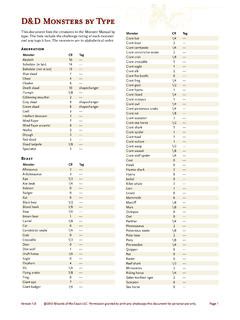Transcription of 5.33 Lecture Notes: Introduction to Spectroscopy
1 Lecture Notes: Introduction to Spectroscopy What is Spectroscopy ? Studying the properties of matter through its interaction with different frequency components of the electromagnetic spectrum. Latin: spectron ghost or spirit Greek: to see With light, you aren t looking directly at the molecule the matter but its ghost. You observe the light s interaction with different degrees of freedom of the molecule. Each type of Spectroscopy different light frequency gives a different picture the spectrum. Spectroscopy is a general methodology that can be adapted in many ways to extract the information you need (energies of electronic, vibrational, rotational states, structure and symmetry of molecules, dynamic information). Goals: Understand how light interacts with matter and how you can use this to quantitatively understand your sample.
2 Understand Spectroscopy the way you understand other common tools of measurement like the watch or the ruler. See that Spectroscopy is a set of tools that you can put together in different ways to understand systems solve chemical problems. The immediate questions that we want to address are: What does light do to sample? How do you produce a spectrum? What EXACTLY is a spectrum a measurement of? Lecture Notes: Introduction to Spectroscopy Page 2 1 What does a spectrum measure? Interaction of light with a sample can influence the sample and/or the light. Method involves: (1) excitation and (2) detection. The basic idea: Light ( wave) In most spectroscopies, we characterize how a sample modifies light entering it.
3 1) Absorption: Change in intensity I of incident light Sample attenuates light transmission T=I/I0 We measure the absorption of light at different frequency or wavelength. / / (characteristic frequency/wavelength of light entering sample) Sample Characterize light after sample. Characterize change in sample. (photoacoustic spec.) This borders on photochemistryOther excitation Lecture Notes: Introduction to Spectroscopy Page 3 2) Emission: Excitation induces emission of light from the sample (usually of different frequency). (Emitted in all directions) Includes: Fluorescence (emission from excited electronic singlet states) Phosphorescence (emission from excited electronic triplet states) Raman Scattering (light scattering involving vibrational transition) 3) Optical Rotation: Change of phase of light incident on sample (rotation of polarization) Let s work on describing absorption.
4 Let s look at a typical absorption spectrum. sampledetector in outA / Lecture Notes: Introduction to Spectroscopy Page 4 What are the axes? X-axis: Characterizes the input light in terms of frequency-wavelength-energy Wavelength (nm, m, ), Frequency (cycles/sec or s-1 or Hz) c2 == = 2 (rad/sec) (angular frequency) = /2 c = 1/ expressed in units of cm-1 (wavenumbers) Energy E = h (expressed as eV or as cm-1 using E/hc = /c) Conversions ( cm-1 ) = 107 / ( nm ) ( eV ) = 1240 / ( nm ) y-axis: Absorption ()()0 IAlog cLI = = (Beer s Law) I0 = light intensity incident on the sample I = light intensity after the sample = molar decadic extinction coefficient M 1cm 1() the molecular quantity c = concentration (M) L = sample length (cm) This comes from assuming that the fraction of light absorbed as you propagate though the sample is proportional to the distance traversed: dI Idx= Lecture Notes: Introduction to Spectroscopy Page 5 How do your measure absorption spectra?
5 Measure the change of intensity of light at different frequencies as it passes through a sample. Two types of spectrometers: 1) Dispersive 2) Fourier transform Dispersive spectrometer: Separate different frequency components Well talk about Fourier transform spectrometers later. This is a way of processing all wavelength/frequencies simultaneously IR/NMR redbluesampledetectorslitprismI0I / / A















